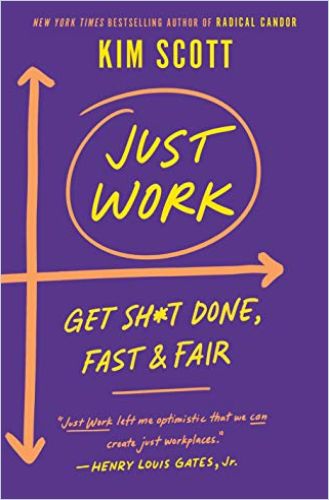Bestselling author of Radical Candor Kim Scott details the policies and environment necessary to inspire and sustain a just workplace.

A Safe Workplace
In a worthy follow-up to her bestseller Radical Candor, Kim Scott offers a detailed, actionable framework for building a fair and equitable workplace, one that ensures employees reach their full potential in a safe environment. She defines the overt and covert manifestations of workplace injustice – from bias to harassment, normalized misogyny t0 bullying – and offers practical, current advice about how to recognize, address and eliminate it.
Bias, Prejudice and Bullying
Bias, prejudice and bullying prevent “Just Work,” as do discrimination, verbal harassment and physical altercations. Scott provides clear, fundamental definitions for each type of injustice.
Biases stem from stereotypes. Stereotypes can lead people to make biased assumptions about someone’s role, background, duties, intelligence or expertise. For example, a white, male executive may routinely ask a female employee to take notes, get coffee or make restaurant reservations. Pointing out biases diplomatically is often enough to prompt people to see and correct their misconceptions.
Prejudice, however, is more willful; draw boundaries to prevent people from imposing their prejudice on others. For example, a male manager hires strippers for a work party, thus subjecting female colleagues to normalized misogyny.
Bullying is the intentional effort to harm someone defined as “other.” Bullies aim to intimidate and torment. Impose real and clear consequences on bullies.
Victims, Upstanders, Perpetrators and Leaders
Workplace injustice generates four roles: the victim; the upstander; the individual who caused harm; and the leader who responds to it. These roles might change, intersect or overlap.
As a victim, your priority is to take care of yourself. Choose how you wish to respond – or not to.
If you witness workplace injustice, be an upstander: intervene or offer support.When confronting bias as an upstander, avoid statements that attack the instigator’s character. Instead, help the person see his or her behavior from your perspective. Even one person pushing back can often stop the behavior.
Upstanders have greater impact in homogenous workplaces because they ensure underrepresented employees needn’t bear the burden of handling workplace affronts alone.
If employees took their roles as upstanders seriously, they could transform the workplace everywhere on the planet.
Kim Scott
When someone indicates your behavior harmed another person – that is, you are the perpetrator – learn from the feedback. Ask co-workers to point out actions or statements that expose your own unconscious biases. Acknowledge your missteps, apologize to the person harmed and make amends. Focus on the harmful effect of your words or actions – not your good intentions.
By acting consciously and with intention, leaders can minimize the ways in which biases skew decision-making and cause us to act irrationally. Kim Scott
As a leader, notice, respond to and impose consequences for harmful actions. Actively work to prevent discriminatory or bullying behavior. Document every instance of bullying. Stop bullies with direct confrontation. When leaders fail to intervene, Scott repeatedly underscores, workplace inequality only worsens.
“I,” “It” and “You” Statements
Responding to an offense, while uncomfortable, can help you feel in control, inspire others to do the same, and may spark a conversation that helps the offender correct his or her behavior.
The reason to confront prejudice is to draw a bright line between that person’s right to believe whatever they want and your right not to have that belief imposed upon you.Kim Scott
When confronting bias, craft an “I” statement to invite the recipient to share your viewpoint. For example, “Like you, I don’t normally carry safety pins, but you may find one in the restroom.” When responding to prejudice, use an “it” statement, such as: “It is disrespectful and insulting to call a grown woman a girl.” A bully wants to intimidate you, so don’t bother pointing out the behavior and how it makes you feel. Bullies stop only when faced with consequences. Respond to bullying with “you” statements, such as, “You need to stop talking to me that way.”
Document and Report
Create a code of conduct that explicitly establishes, defines and communicates unacceptable workplace behavior and spells out consequences for violations. Scott urges you to document harassment, including the time and place, and the perpetrator’s actions and speech; retain offensive emails and texts; recruit friends and co-workers for support; and explore alternate job options.
Report violations to HR. If necessary, pursue legal action or go public. At the same time, institute trustworthy reporting systems that allow victims to make accusations anonymously if they chose.
Confrontation has obvious costs and hidden benefits; silence has hidden costs and obvious benefits. The more aware you are of both the obvious costs and hidden benefits, the better your decision will be.Kim Scott
Create a culture of consent to prevent physical violations, from unwanted touching to sexual assault. Unwanted touching includes kissing someone’s hand, holding a handshake too long or giving an unwelcome hug. It’s never your fault if someone sexually assaults you when you are intoxicated. Having sex with someone too intoxicated to consent is rape.
Practical and Actionable
Scott offers what is essentially a manual – a practical, efficient set of actions to pursue and guidelines to enact. Scott’s directives are straightforward and functional. At times, she contradicts herself regarding philosophies and links between actions and intentions, which suggests a certain hurry-up in the writing, perhaps to capitalize on her justifiably bestselling Radical Candor.
Scott’s easy to read, though, and her hard-nosed guidance is peppered with touching hopefulness. Her clarity, brevity and welcome straightforwardness make the entire book an essential to-do list for any office seeking a just environment. You can enact her advice as a manager, colleague or executive.
Kim Scott also wrote The New York Times bestseller Radical Candor; The Measurement Problem; Virtual Love; and The Househusband. Other noteworthy books on creating safe workplaces include, The 4 Stages of Psychological Safety by Timothy R. Clark and The Fearless Organization by Amy C. Edmondson.














